The first Milstar protected communications satellite, launched 20 years ago on February 7, 1994, gave U.S. national and defense leaders a new capability: Assured communications day or night, without detection or interception under any level of military conflict.
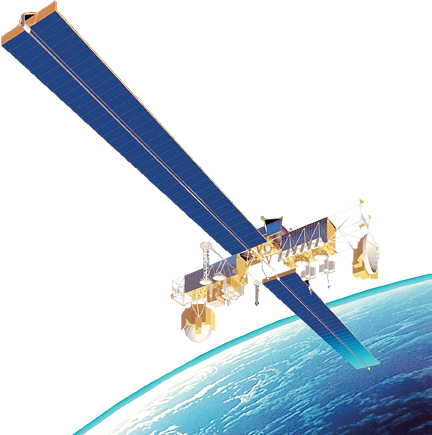
Now the satellite, with a Northrop Grumman-designed and -built low data rate (LDR) payload, has achieved an unprecedented 20 years of successful on-orbit operations, or double its design life. The LDR payload is the operational heart of Milstar Flight 1, featuring autonomous processing, routing and network management capabilities.
In the payload’s lifetime, it has provided more than 166,000 hours of service, with more than 99 percent availability. Hundreds of users have to access the system at any given time, which operates in geostationary orbit.
The Milstar Flight 1 payload is still fully mission-capable, a completely integrated component of the MILSATCOM constellation of satellites that provides protected communications worldwide via satellite-to-satellite crosslinks.
The expectation is for the satellite to continue providing secure communications to U.S. and Allied Forces for years to come. Today, Milstar Flight 1 continues to provide assured voice and data communications for strategic users.
Six Milstar satellites were launched between 1994 and 2003. Northrop Grumman provided Milstar payloads to system prime contractor Lockheed Martin Space Systems, Sunnyvale, California, as it does for the Advanced Extremely High Frequency (AEHF) current generation of protected communication satellites.
The payload is the mission-specific module containing the complete set of processing, routing and control hardware and software that perform the satellite’s communications function. Milstar payloads also house all critical features needed to protect against interception or jamming threats.
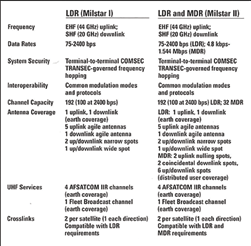
Milstar payload performance features
The Most Secure SATCOM System Ever
These payloads made Milstar the most protected, secure and most advanced satellite communication system ever deployed, as well as the most technologically adaptable satellite system for the needs of its users. As the communication functions are configurable in digital and software-based processors, the national command has been able to configure the communication resources according to need. In addition, during these 20 years, new versions of the processor software have been updated to deliver enhanced capabilities without the need to design and build new satellites.
The LDR payload distinguished itself through several groundbreaking achievements. In addition to its autonomous processing, routing and network management capabilities, the payload offered military users several other important “firsts.” This was the first satellite payload to:
• Allow members of all the armed services to communicate with each other on the same network
• On board processing for the most reliable digital communications, crosslinks and “switchboard-in-the-sky” for global connectivity
• Offer its users secure, jam-proof communications, even under the most rigorous jamming scenarios
• Provide instant, in-theater communications infrastructure for mobile users
• Support direct communication through satellite-to-satellite crosslinks, without the assistance of costly or potentially vulnerable ground stations
Evolution To AEHF
Starting with Block 1 satellites, or those with LDR capabilities, Milstar was originally intended to provide strategic capabilities. An evolution in capabilities enhancement began when the Milstar program expanded communications to the tactical realm with the advance to medium data rates (MDR) in Block 2.
Milstar MDR payloads meant that troops on the move could remain in communication at the regimental level—without having to stop and set up a line-of-sight antenna to communicate among various units. Under Milstar Block 1, the military had secure voice communications. With the advent of Block 2, troops could send large data files by satellite for the first time.
The introduction of AEHF payloads moves communications one step farther with extended data rates. To show the dramatic improvements made possible by this evolution in protected MILSATCOM, the U.S. Air Force cites these examples:
• A 1.1-megabyte air tasking order takes 1.02 hours to transmit over Milstar I; only 5.7 seconds over Milstar II; and 1.07 seconds over AEHF.
• For imagery, the Air Force says it takes 22.2 hours, almost a full day, to transmit 24 megabytes from an annotated 8 x 10 photograph over Milstar I. Milstar II reduces this time to 2.07 minutes for the same imagery, and it takes only 23.6 seconds with AEHF.
Milstar Flight 1 was the dawning of a vision for protected MILSATCOM that was initiated some 30 years ago. Today, five Milstar satellites and three AEHF satellites are delivering an unprecedented level of immunity to jamming, interference and detection that gives our military forces an advantage no other nation possesses.
The eight satellites are cross-linked into a constellation the Air Force aptly describes as a “ring of protection” around the Earth for secure and assured communications for military users operating in a broad set of mission areas. Milstar Flight 1 set the tone for performance and flexibility that will characterize the ring of protection long into the future.

About the author
Peggy Paul is responsible for the on-orbit support of the reconfigurable MILSATCOM communication network of satellite payloads that provides warfighters and the National Command Authority with worldwide protected communications. Ms. Paul is synonymous with Milstar’s success. She started her career with TRW as a member of the System Engineering technical staff, where she led development of the Milstar Flight 1 payload verification. She became program manager for Milstar Flights 5 and 6 payloads, where she was responsible for delivery, activation and incorporation of those payloads into the Milstar network. Most recently, she returned to the MILSATCOM programs as Program Manager with responsibility for the launch, activation and integration of the AEHF payloads as well as the on-orbit support of Milstar and AEHF payloads.
Peeking At The Payloads
The Northrop Grumman-built Milstar LDR payload receives uplink user signals on nine EHF receive antenna beams. The uplink signals are demodulated and routed to destinations assigned by the onboard computers, which mark the world’s first “bandwidth on demand” satellite communications. Data are also received via crosslinks from other Milstar satellites in the constellation. Received user data may be routed either to onboard destinations, to one of five downlink antennas, or to the crosslinks for connections through other Milstar satellites that form a “closed ring” enabling secure, Milstar communications from point to point anywhere on Earth.

A Milstar payload undergoes integration and tests at Northrop Grumman’s facilities in Redondo Beach, California. Photo is courtesy of Northrop Grumman.
The SHF downlink subsystem modulates and transmits the signal through the downlink antennas. A UHF subsystem provides interoperable UHF communications and a fleet broadcast channel. Milstar supports communications to man-transportable terminals.
Medium Data Rate (MDR) Payload
For the Milstar medium data rate (MDR) payloads that fly aboard Flights 4, 5 and 6, Northrop Grumman Space Technology supplies two types of antennas and the digital processing subsystem. MDR’s data rates—as high as 1.55 megabits per second (MBPS)—accommodate voice and data, imagery and targeting intelligence at the 1.55 mbps rate on each of 32 uplink channels. This capability greatly increases the capacity of the Milstar system and supports new missions, such as high-capacity links between Navy shore stations and ships at sea.
The MDR payload’s Northrop Grumman-developed nulling antennas are capable, without any instruction from a ground station, of detecting and then countering enemy signal-jamming. This revolutionary capability was developed for Milstar II, with each MDR payload carrying two nulling antennas. The nulling antennas are well suited to Army coverage requirements, where many troops may occupy a relatively small theater of operations near the enemy. The Army, therefore needs coverage with protection against close-in jamming.
Six smaller Northrop Grumman-built MDR antennas produce spot beams and 1.55mbps data rates without the nulling. These are called distributed user coverage antennas (DUCAs) and are best matched to the dispersed, global-type requirements of the Navy, which operates ships and shore stations around the world. Navy vessels and bases tend to be removed from the front and the threat of close-in jamming is much less likely.
Milstar II’s Digital Processing—Key To The MDR Payload
Milstar II satellites (see the info box, top of the next column) will benefit from a Northrop Grumman-developed digital processing subsystem that delivers data 640 times faster than Milstar I payloads, while capitalizing on dramatic advances in microelectronics and manufacturing processes to lower payload costs, weight, and part counts. The result is a system well adapted to fast-moving tactical military uses, as well as one that preserves Milstar’s core communications requirements for worldwide, antijam, scintillation-resistant services with low probability of interception.
The digital processing subsystem, combined with the RF subsystem built by Boeing Satellite Systems, constitutes the medium data rate (MDR) payload electronics package. Boeing integrates the MDR payload for Milstar prime contractor Lockheed Martin. MDR services will provide U.S.
military forces with on-demand availability of interactive voice, video, and data links at rates up to 1.544 megabits per second. That’s more than 50 times faster than the 28.8-kilobit-per-second modem used with many personal computers.
The MDR payload is tailored to meet the needs of third world threats and regional conflicts. Flexible onboard processing instantly reconfigures networks to suit evolving command and control requirements.
The use of EHF frequencies and highly directional nulling antennas reduce the probability of jamming and intercept. Lightweight portable terminals on land, sea, and in the air can be easily moved during tactical operations.
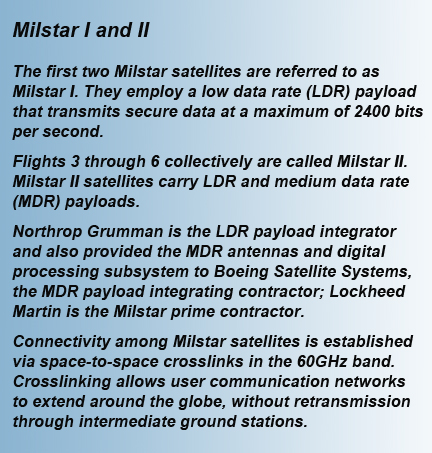
Quickly changing battlefield conditions and spontaneous requirements for interservice connectivity demand Milstar’s highly sophisticated onboard network configuration capabilities.
Each MDR payload has eight antennas, each independently steerable and operating at extremely high frequencies (EHF). Terminal users may communicate with other users within the same antenna beam or with users located in other MDR antenna beams from any of the Milstar II satellites. The on-orbit digital router establishes and maintains links within and among beams and responds to users’ changing and differing bandwidth requirements.
From each uplink beam the MDR payload processes the communication data, sorting and routing them to the proper downlink beams. If a data destination is found to lie outside the areas covered by a satellite’s antenna beams, the payload routes the message via crosslink antenna to another satellite for downlinking.
In addition to sorting and routing messages, the digital processing subsystem performs other key functions such as demodulation of the EHF signal, authenticating and granting user access, and dynamically configuring payload resources (antennas, receivers, processors, etc.) to establish networks and provide bandwidth on demand.
To perform these complex functions, the MDR digital processing subsystem relies on 14 custom application-specific integrated circuits and 397 large-scale integrated (LSI) circuits, all fabricated in CMOS technology. This figure represents a decrease of 37 percent from the 630 custom LSI circuits required for each LDR payload.
Fast, Flexible, MDR Flight Software
The software that controls MDR payload resources, like the processors it runs on, delivers higher performance at reduced cost than its flight-proven counterpart in the LDR payload.
The software is responsible for managing all MDR payload resources (uplink, downlink, and crosslink) employed for user communication. The software acts as a “switchboard in space,” dynamically changing the routing path of communications data, based upon user requests.
In addition the software performs all the multi-satellite coordination with other Milstar satellites to support worldwide communications without resorting to intermediate ground links.
The ability to improve performance and functionality while lowering development risk and reducing cost stems largely from two key factors. One is the selection of the Milstar Advanced Processor (MAP) as the MDR resource controller. MAP is a high-performance, general-purpose computer, developed for the Milstar program and used in other capacities on Milstar spacecraft. The other risk- and cost-reduction factor is the extensive reuse of LDR processing design and software code, which shortened development time dramatically.
In addition, Milstar requirements and external interfaces were already well defined by the time MDR development began. Although software in the MDR and LDR payloads provides similar functionality, the MDR software incorporates a number of important system improvements. MDR software:
• Employs a centralized database architecture. This means that database information about users is not duplicated on multiple satellites. Instead, service operations are coordinated by a single satellite with full service information. Centralizing this function simplifies multi-satellite coordination and lowers the amount of crosslink traffic devoted to system administration “overhead.”
• Adds a new “fencing” capability. Fencing ensures that designated user groups in the three military services can procure access to allotted satellite resources. In times of crisis, fencing guarantees these user groups Milstar availability.
• Increases system flexibility. The software is both configurable and uploadable from the ground. This feature provides the ability to add software patches and improvements “on the fly,” or to replace the software with an updated version.
• Supports LDR-aided acquisition of the MDR payload. This feature permits LDR users to log onto the MDR payload.
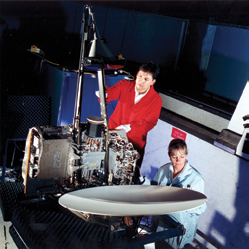
Technicians adjust a nulling antenna for a Milstar protected communications payload. Photo is courtesy of Northrop Grumman.
Savings In Time, Weight + Power
Payload engineers took advantage of advances in microelectronics technology to pack more processing power into smaller digital units, or “configured items,” as the boxes are called. For example, the MDR digital processing subsystem requires only two configured items to perform demodulation and routing functions. The LDR payload management subsystem (PMS) required four configured items to perform the same two functions. Overall, the MDR’s digital subsystem weighs about 40 percent less than its equivalent configured units on the LDR PMS. The MDR units consume only half the power of their LDR counterparts.
The MDR design also paid off in savings of time and manpower. The integration and acceptance of the MDR digital processing subsystem took less than three months, about half the time required to complete the same tasks for the LDR PMS. In addition, the size of the crew needed for integration and test was reduced by one-fourth. Add the savings in support personnel and the manpower required for integration and acceptance testing was cut in half.
MDR Digital Processing Demonstrates Continuous Milstar Improvements
The MDR payload boosts Milstar performance by giving forces in the field the wideband services they need for high-speed communications and dynamic network configuration. The payload also demonstrates the Milstar program’s ongoing progress in providing greater performance from electronic payload units that weigh less, consume less power, and require fewer people to build and test. All of which is necessary to meet the U.S. military evolving communications needs in the post-Cold War world.
Milstar MDR Nulling Antennas: Ensuring Secure Tactical Military Communications
The medium data rate (MDR) payload of Milstar II satellites (see box below) — delivering data to field terminals at T1 rates of 1.544 megabits per second, or more than 25 times the speed of a 56 kilobit-per-second computer modem — will make possible secure, real-time transmission of voice, image and data among tactical users. Northrop Grumman-developed adaptive nulling antennas on each MDR payload protect Milstar MDR communications against electronic jamming by enemy forces. Each “nuller” is a fully autonomous antenna system that continuously maximizes user signals while minimizing jammer signals.
The MDR Antenna Suite
The MDR payload’s antenna suite is designed to meet the diverse needs of Milstar users. The Army, for example, deploys large numbers of troops in a relatively small theater of operations, where the bulk of communications is in theater. Therefore, the Army needs to cover a small geographic area with one or two payload antennas. The Navy, by contrast, operates ships on every ocean and has shore stations around the world. The Navy needs as many antennas as possible covering the portion of Earth visible from the satellite.

Northrop Grumman employees conduct tests of Milstar’s dual use coverage antennas. Photo is courtesy of Northrop Grumman.
Close-in jamming (where jammer and friendly terminals are both located within a single antenna beam) is a serious threat to the Army, which tends to operate near the front, close to enemy jammers. The Navy often operates from bases and carriers some distance from the front, where the jammers are often out of beam.
Two nulling antennas onboard each MDR payload are capable of negating the effects of both in-beam and out-of-beam jammers. In addition, the MDR payload carries six smaller antennas that produce spot beams without nulling. These are called Distributed User Coverage Antennas (DUCAs). Generally speaking, the nulling antennas are best matched to theater-type requirements, while DUCAs better match those of dispersed global users such as the Navy.
Adaptive Nulling: How The Nulling Antenna Works
Milstar satellites and ground terminals employ a spread-spectrum approach in which the signal hops in pseudo-random fashion from frequency to frequency within an assigned bandwidth. User terminals communicate with the satellite using a secure frequency hopping pattern shared by the terminal and the satellite.
In the absence of jammers, user signals received by the nulling antenna fall within an expected distribution of frequencies. When a jammer terminal begins operating within the satellite’s spot beam coverage area, its radiated power does not follow the satellite’s frequency-hopping pattern. As a result, anomalies appear in the nuller’s power distribution curve, revealing the presence of jamming signals.
The antenna takes immediate steps to eliminate these unwanted signals. It calculates appropriate signal-weighting factors for the power received at each antenna feed to determine the position of the jammer and produces a null in that direction.
The MDR nulling antenna consists of four major components:
• Multibeam reflector and feeds. The MDR nuller produces 13 essentially non-overlapping narrow spot beams. Its design is based on a 40-inch offset-Cassegrain reflector, which illuminates a 13-element feed array. Each antenna is gimbaled and can be independently steered to any position on the visible Earth.
• Beamformer. A millimeter-wave beamformer provides sum and sample signals to a radio frequency combiner, which establishes the received radiation pattern. The pattern, of course, includes nulls that block out jammer signals.
• Correlator. The correlator constantly monitors each of the 13 EHF feed inputs, determines whether a jammer is present, and then computes baseband error weightings.
• Digital processor. Error signals produced by the correlator are passed to the processor. The processor updates the beamformer weights to drive the errors toward zero. As error weightings coming from the correlator are progressively reduced, the beamformer shapes a null in the antenna pattern in the direction of the jammer.
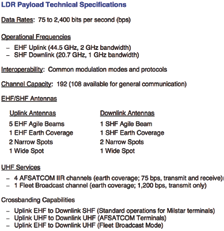
Northrop Grumman also developed the algorithm for the nulling antenna processor. The Northrop Grumman-patented algorithm determines the weight updates from the correlator error signals. The algorithm’s performance, along with the speed of the processor, is essential to the nulling antenna’s ability to counter jammers.
Nulling: Key to MDR Performance
The complex signal-processing algorithms required for adaptive nulling have existed for some time. Only in recent years, however, have advances in microelectronics enabled engineers to design a fully autonomous nulling antenna system light enough and compact enough to fly aboard a spacecraft.
Northrop Grumman delivered the first flight nulling antenna to MDR payload integrating contractor, Boeing Satellite Systems, in October 1996.
The MDR nulling antennas do far more than simply receive RF signals. Each antenna is a complete feedback control system designed to continuously maximize desired signals while processing out jamming signals. With nulling antennas in operation, the Milstar MDR payload can push data rates to 1.544 megabits per second. Or, by switching to lower data rates, it can receive signals from small, low-power ground terminals. Or the antenna can operate at some intermediate combination of data rate and terminal power, all without sacrificing anti-jam performance.
Editor’s note:
The preceding information is courtesy of Northrop Grumman.


